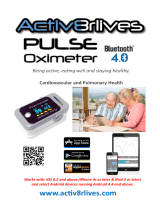
Table of Contents
Introduction.....................................................................1
Keys............................................................................................ 1
GPS Status and Status Icons................................................ 1
Pairing Your Smartphone with Your Device............................... 1
Tips for Existing Garmin Connect Users................................ 1
Enabling Bluetooth Notifications............................................ 1
Viewing Notifications......................................................... 1
Managing Notifications...................................................... 1
Playing Audio Prompts on Your Smartphone During Your
Activity
............................................................................... 2
Turning Off the Bluetooth Smartphone Connection.......... 2
Turning On and Off Smartphone Connection Alerts......... 2
Viewing the Controls Menu......................................................... 2
Going for a Run.......................................................................... 2
Activities and Apps........................................................ 2
Starting an Activity...................................................................... 2
Tips for Recording Activities.................................................. 3
Stopping an Activity.................................................................... 3
Adding an Activity....................................................................... 3
Creating a Custom Activity.....................................................3
Indoor Activities.......................................................................... 3
Recording a Strength Training Activity...................................3
Tips for Recording Strength Training Activities................. 3
Calibrating the Treadmill Distance......................................... 4
Swimming.............................................................................. 4
Going for a Pool Swim...................................................... 4
Swim Terminology.............................................................4
Stroke Types..................................................................... 4
Tips for Swimming Activities............................................. 4
Resting During Pool Swimming.........................................4
Training with the Drill Log..................................................4
Outdoor Activities........................................................................4
Playing Audio Prompts During Your Activity............................... 4
Training........................................................................... 5
Workouts.....................................................................................5
Following a Workout From the Web.......................................5
Creating a Custom Workout on Garmin Connect.................. 5
Sending a Custom Workout to Your Device.......................... 5
Starting a Workout................................................................. 5
About the Training Calendar.................................................. 5
Using Garmin Connect Training Plans...................................5
Adaptive Training Plans......................................................... 5
Starting Today's Workout.................................................. 5
Interval Workouts................................................................... 5
Creating an Interval Workout............................................ 5
Starting an Interval Workout..............................................6
Stopping an Interval Workout............................................ 6
Using Virtual Partner®................................................................ 6
Setting a Training Target............................................................ 6
Cancelling a Training Target.................................................. 6
Racing a Previous Activity.......................................................... 6
Personal Records....................................................................... 6
Viewing Your Personal Records............................................ 6
Restoring a Personal Record................................................. 6
Clearing a Personal Record................................................... 7
Clearing All Personal Records............................................... 7
Using the Metronome................................................................. 7
Setting Up Your User Profile.......................................................7
Fitness Goals......................................................................... 7
About Heart Rate Zones........................................................ 7
Setting Your Heart Rate Zones......................................... 7
Letting the Device Set Your Heart Rate Zones................. 7
Heart Rate Zone Calculations........................................... 8
Activity Tracking............................................................ 8
Auto Goal.................................................................................... 8
Using the Move Alert.................................................................. 8
Turning on the Move Alert......................................................8
Sleep Tracking............................................................................ 8
Using Automated Sleep Tracking.......................................... 8
Using Do Not Disturb Mode................................................... 8
Intensity Minutes......................................................................... 8
Earning Intensity Minutes.......................................................8
Garmin Move IQ™ Events.......................................................... 8
Activity Tracking Settings............................................................8
Turning Off Activity Tracking.................................................. 9
Smart Features............................................................... 9
Bluetooth Connected Features................................................... 9
Updating the Software Using the Garmin Connect App........ 9
Manually Syncing Data with Garmin Connect........................9
Locating a Lost Mobile Device.................................................... 9
Widgets....................................................................................... 9
Viewing the Widgets............................................................ 10
About My Day..................................................................10
Viewing the Weather Widget........................................... 10
Connect IQ Features................................................................ 10
Downloading Connect IQ Features Using Your Computer.. 10
Wi‑Fi Connected Features........................................................ 10
Connecting to a Wi‑Fi Network............................................ 10
Safety and Tracking Features...................................................10
Adding Emergency Contacts............................................... 10
Turning Incident Detection On and Off................................ 10
Requesting Assistance........................................................ 11
Heart Rate Features..................................................... 11
Wrist-based Heart Rate............................................................ 11
Wearing the Device..............................................................11
Tips for Erratic Heart Rate Data...........................................11
Viewing the Heart Rate Widget............................................ 11
Broadcasting Heart Rate Data to Garmin Devices.............. 11
Broadcasting Heart Rate Data During an Activity........... 11
Setting an Abnormal Heart Rate Alert................................. 11
Turning Off the Wrist-based Heart Rate Monitor................. 12
Running Dynamics....................................................................12
Training with Running Dynamics......................................... 12
Color Gauges and Running Dynamics Data........................ 12
Ground Contact Time Balance Data............................... 12
Vertical Oscillation and Vertical Ratio Data.....................13
Tips for Missing Running Dynamics Data............................ 13
Performance Measurements.................................................... 13
Turning Off Performance Notifications................................. 13
Detecting Your Heart Rate Automatically............................ 13
Syncing Activities and Performance Measurements........... 13
Training Status..................................................................... 14
Tips for Getting Your Training Status.............................. 14
About VO2 Max. Estimates.................................................. 14
Getting Your VO2 Max. Estimate for Running..................... 14
Recovery Time..................................................................... 14
Viewing Your Recovery Time.......................................... 14
Recovery Heart Rate........................................................... 15
Training Load....................................................................... 15
Viewing Your Predicted Race Times................................... 15
Performance Condition........................................................ 15
About Training Effect........................................................... 15
Pulse Oximeter......................................................................... 15
Getting Pulse Oximeter Readings........................................16
Turning On Pulse Oximeter Sleep Tracking........................ 16
Tips for Erratic Pulse Oximeter Data................................... 16
Heart Rate Variability and Stress Level.................................... 16
Using the Stress Level Widget............................................. 16
Body Battery............................................................................. 16
Table of Contents i




















